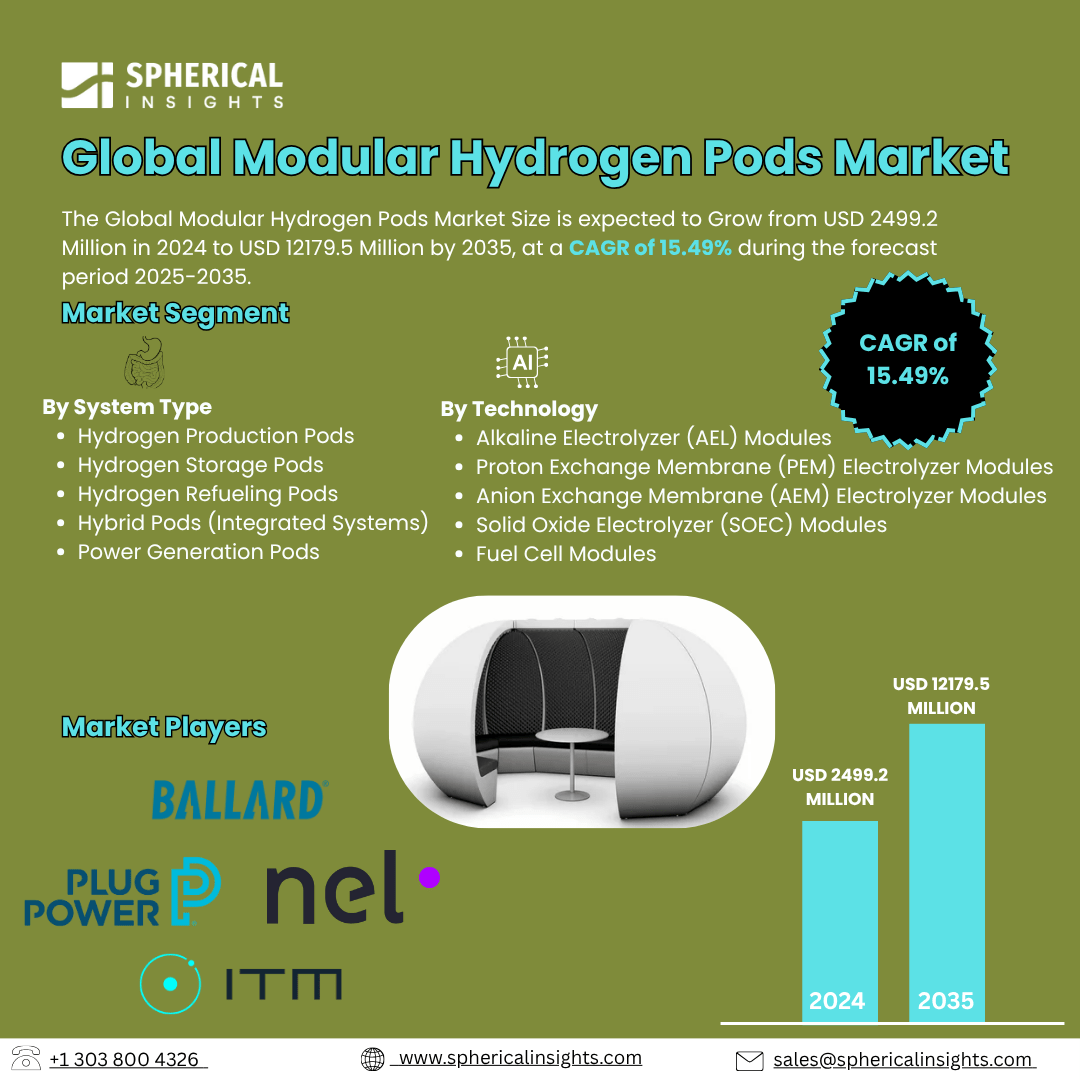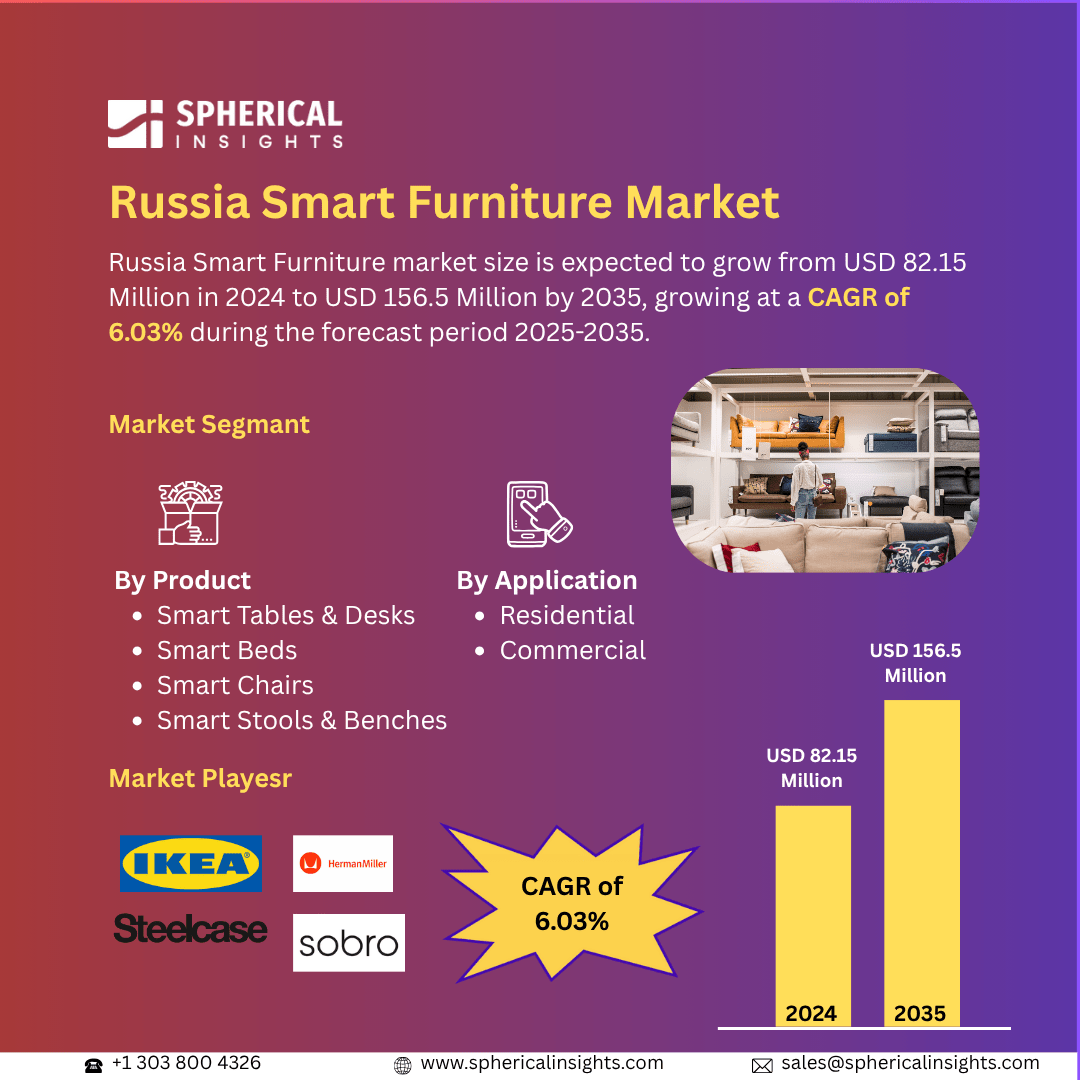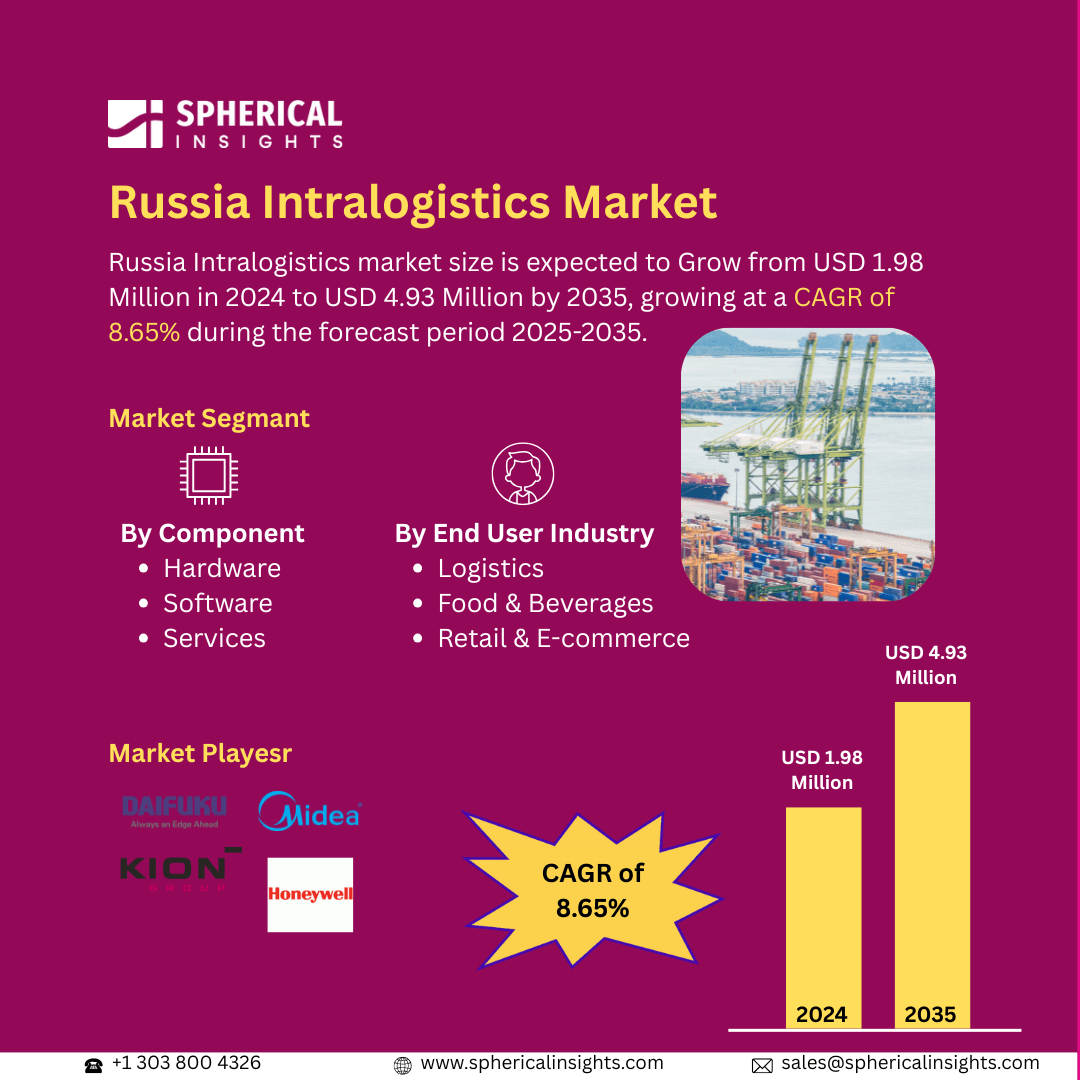Modular Hydrogen Pods Market Summary, Size & Emerging Trends
According to Decision Advisor, The Global Modular Hydrogen Pods Market Size is expected to Grow from USD 2499.2 Million in 2024 to USD 12179.5 Million by 2035, at a CAGR of 15.49% during the forecast period 2025-2035. Rising adoption of hydrogen-based solutions in energy, transportation, and industrial sectors is a key factor driving the modular hydrogen pods market.
Key Market Insights
- Asia Pacific is expected to account for the largest share in the modular hydrogen pods market during the forecast period.
- In terms of system type, hydrogen production pods dominated in terms of revenue during the forecast period.
- In terms of technology, proton exchange membrane (PEM) electrolyzer modules accounted for the largest revenue share in the global modular hydrogen pods market during the forecast period.
Global Market Forecast and Revenue Outlook
- 2024 Market Size: USD 2499.2 Million
- 2035 Projected Market Size: USD 12179.5 Million
- CAGR (2025-2035): 15.49%
- Asia Pacific: Largest market in 2024
- North America: Fastest growing market
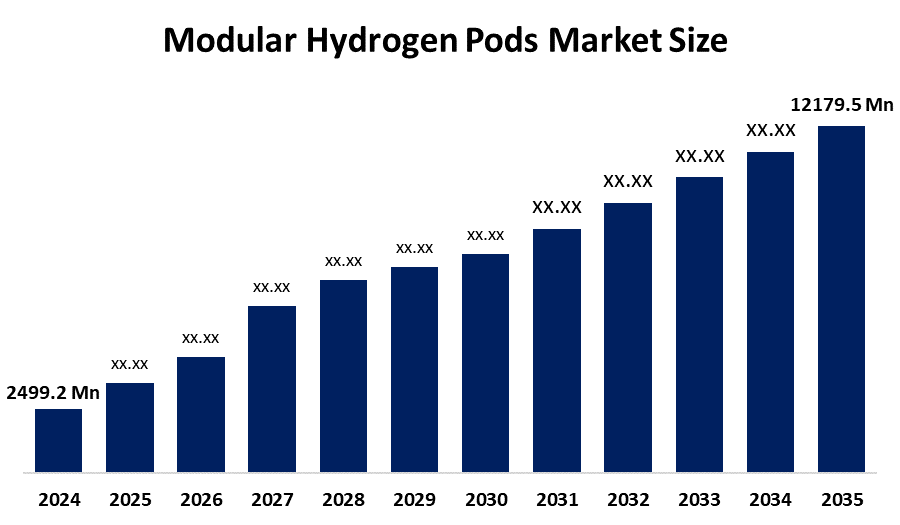
Modular Hydrogen Pods Market
The Modular Hydrogen Pods Market Size focuses on the development of compact and transportable hydrogen solutions essential for energy transition and decarbonization. These pods enable on-site hydrogen production, storage, refueling, and power generation, reducing reliance on large-scale centralized facilities. Hydrogen production pods use electrolyzers to generate green hydrogen from water, while storage and refueling pods ensure safe and efficient hydrogen supply for industrial, mobility, and power applications. Governments worldwide support the market with initiatives promoting hydrogen adoption, offering subsidies, and funding infrastructure projects. The demand is fueled by increasing renewable energy integration, decarbonization targets, and the global push for clean mobility and sustainable energy solutions.
Modular Hydrogen Pods Market Trends
- Rising investment in green hydrogen technologies to reduce carbon emissions.
- Integration of hybrid systems combining production, storage, and power generation for efficient hydrogen solutions.
- Strategic partnerships and collaborations to expand global deployment and technology adoption.
Modular Hydrogen Pods Market Dynamics
Driving Factors: Growing demand from energy, transportation, and industrial sectors
The adoption of modular hydrogen pods is being strongly fueled by the rising demand for clean and flexible energy solutions across various sectors. In the energy sector, the need to decarbonise power generation has created significant interest in hydrogen as a storage and fuel option, particularly in regions with high renewable energy penetration. Modular hydrogen pods allow for on-site hydrogen production and storage, making energy systems more resilient and less dependent on large-scale centralised hydrogen infrastructure. In the transportation sector, hydrogen fuel cell vehicles (FCVs), including buses, trucks, and trains, are gaining traction as zero-emission alternatives to conventional fossil-fuel vehicles. The availability of modular hydrogen refuelling pods simplifies infrastructure deployment and addresses range and refuelling concerns for commercial fleets.
Restraint Factors: High capital cost and technological complexity
Despite the promising growth potential, the modular hydrogen pods market faces significant challenges due to high initial investment requirements. The cost of producing, deploying, and maintaining these pods including advanced electrolysers, fuel cells, and safety systems can be prohibitive, particularly for small-scale or emerging market players. Additionally, the technology behind modular hydrogen pods is complex. Efficient integration of production, storage, refueling, and power generation systems requires sophisticated engineering, operational expertise, and adherence to strict safety standards.
Opportunities: Rapid technological innovations and green hydrogen adoption
The modular hydrogen pods market presents numerous opportunities, primarily driven by technological innovation. Advances in electrolyser efficiency, fuel cell performance, and hybrid pod designs allow for more compact, cost-effective, and scalable hydrogen solutions. These innovations enable modular pods to be deployed in remote locations, industrial sites, and urban mobility hubs with minimal operational challenges. The global push toward green hydrogen produced from renewable energy sources is creating opportunities for modular hydrogen pods in sectors such as transportation, energy storage, and industrial feedstock. Governments and industry stakeholders are investing heavily in hydrogen mobility projects, renewable energy integration, and decarbonization policies, which provide additional growth avenues for market players.
Challenges: Infrastructure limitations and supply chain constraints
Despite growing interest, the market faces operational challenges due to limited hydrogen infrastructure. The scarcity of hydrogen refuelling stations, storage facilities, and distribution networks can hinder the adoption of modular hydrogen pods, particularly in developing regions. Without sufficient infrastructure, commercial-scale deployment for mobility and industrial applications remains constrained.
Global Modular Hydrogen Pods Market Ecosystem Analysis
The ecosystem includes raw material suppliers (electrolyzer components, fuel cells, and storage materials), manufacturers of modular hydrogen pods, system integrators, and end-users in industrial, mobility, and energy sectors. Key players focus on R&D, efficiency improvements, and global deployment, while regulatory bodies support sustainable hydrogen adoption. The balance between innovation, regulation, and infrastructure development is crucial for market growth.
Global Modular Hydrogen Pods Market, By System Type
What factors enabled the hydrogen production pods segment to lead the modular hydrogen pods market in revenue in 2024?
The hydrogen production pods segment dominated the modular hydrogen pods market in terms of revenue in 2024, accounting for approximately 45% of the global market share, due to its ability to efficiently produce hydrogen for industrial and energy applications. These pods offer scalability, high energy efficiency, and compatibility with green hydrogen production technologies, making them highly attractive to manufacturers and energy providers seeking sustainable solutions. The segment’s modular design allows for flexible deployment and integration into existing infrastructure, reducing installation time and operational costs. Additionally, rising demand for clean energy and hydrogen as a key component in decarbonization initiatives has further driven adoption.
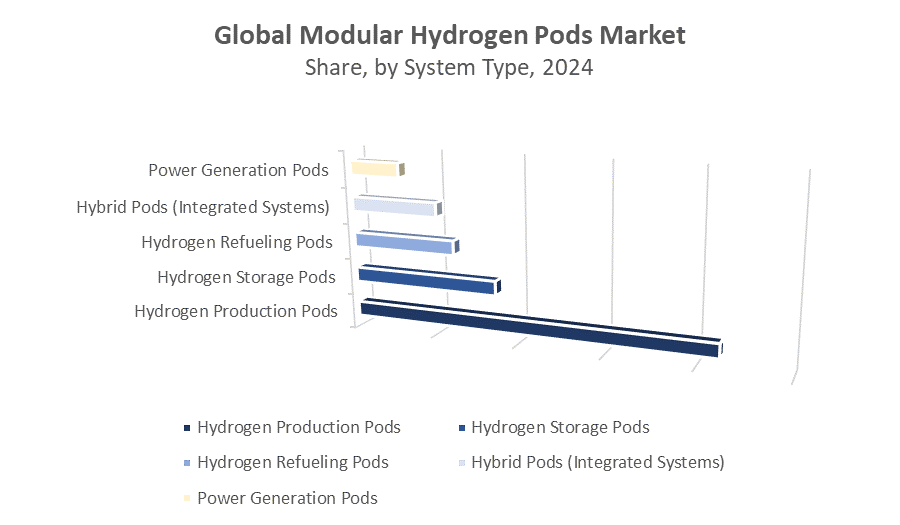
Why did the hydrogen storage pods segment account for approximately 35% of the global modular hydrogen pods market in 2024?
The hydrogen storage pods segment accounted for approximately 35% of the global modular hydrogen pods market share in 2024 and is expected to grow at a strong CAGR during the forecast period due to its critical role in safely storing and managing hydrogen for industrial, transportation, and energy applications. These pods provide reliable storage solutions with high safety standards, pressure management systems, and compatibility with both green and grey hydrogen, which enhances their appeal to a wide range of end users. The modular design allows flexible deployment, easy scalability, and integration with hydrogen production and distribution infrastructure, making it ideal for expanding hydrogen networks.
Global Modular Hydrogen Pods Market, By Technology
How did the AEL modules segment gain a competitive edge in the electrolyzer market?
The alkaline electrolyzer (AEL) modules segment held a significant market share in 2024, accounting for approximately 40% of the global market revenue, due to its proven technology, cost-effectiveness, and scalability in hydrogen production. AEL modules are widely recognized for their reliability, long operational life, and ability to efficiently produce hydrogen from water electrolysis using mature and commercially available components. Their relatively lower capital expenditure compared to emerging electrolyzer technologies makes them attractive for large-scale industrial and energy applications.
What made the PEM electrolyzer modules the top choice for hydrogen production in 2024?
The proton exchange membrane (PEM) electrolyzer modules segment dominated the global market in terms of revenue in 2024 due to its high efficiency, rapid response time, and suitability for integration with renewable energy sources. PEM electrolyzers offer the advantage of producing high-purity hydrogen with compact designs and flexible operational capabilities, making them ideal for both industrial and renewable energy applications. Their ability to handle variable electricity inputs, such as from solar or wind power, provides a significant edge over traditional electrolyzer technologies. Additionally, PEM modules require less water and can operate at higher current densities, allowing faster hydrogen production in limited space.
Asia Pacific emerged as the largest market for modular hydrogen pods in 2024, accounting for approximately 45% of the global market share. The region’s dominance is primarily driven by China, Japan, and South Korea, which are heavily investing in renewable energy integration, hydrogen mobility initiatives, and industrial decarbonization projects. In China, the government’s push for green hydrogen and large-scale renewable energy projects has accelerated the adoption of modular hydrogen pods for both industrial and mobility applications. Japan and South Korea are leading in hydrogen fuel cell vehicle deployment and building a robust hydrogen refuelling infrastructure, further boosting demand. Rapid industrialisation, technological advancements in electrolyzers and storage systems, and supportive government policies make the Asia Pacific the key growth engine for the global market.
North America is the fastest-growing market for modular hydrogen pods, holding approximately 30% of the global market share. Growth is fueled by the adoption of hydrogen fuel cell vehicles (FCVs), expansion of renewable energy projects, and government incentives supporting green hydrogen production. The United States and Canada are witnessing increasing investments in hydrogen infrastructure, industrial applications, and energy storage solutions. Advances in PEM and hybrid hydrogen systems, coupled with federal and state-level subsidies, enable rapid deployment of modular hydrogen pods. The focus on clean energy transition, decarbonization of industrial sectors, and electrification of transport is expected to sustain strong growth in this region over the forecast period.
Europe accounts for approximately 20% of the global market share, experiencing strong growth due to comprehensive EU hydrogen strategies and decarbonization policies. Countries such as Germany, France, and the UK are investing heavily in green hydrogen production, storage, and mobility solutions to meet climate targets and energy security goals. The European market benefits from well-established hydrogen infrastructure, research initiatives, and collaborations between industrial and technology partners. The implementation of renewable hydrogen projects, fuel cell adoption in transportation, and industrial decarbonization programs is accelerating modular hydrogen pod deployment.
WORLDWIDE TOP KEY PLAYERS IN THE MODULAR HYDROGEN PODS MARKET INCLUDE
- Ballard Power Systems
- Nel ASA
- Plug Power Inc.
- ITM Power
- Hexagon Purus
- Hydrogenics Corporation
- Toshiba Energy Systems & Solutions Corporation
- Cummins Inc.
- Siemens Energy
- Others
Market Segment
This study forecasts revenue at global, regional, and country levels from 2020 to 2035. Decision Advisor has segmented the modular hydrogen pods market based on the below-mentioned segments:
Global Modular Hydrogen Pods Market, By System Type
- Hydrogen Production Pods
- Hydrogen Storage Pods
- Hydrogen Refueling Pods
- Hybrid Pods (Integrated Systems)
- Power Generation Pods
Global Modular Hydrogen Pods Market, By Technology
- Alkaline Electrolyzer (AEL) Modules
- Proton Exchange Membrane (PEM) Electrolyzer Modules
- Anion Exchange Membrane (AEM) Electrolyzer Modules
- Solid Oxide Electrolyzer (SOEC) Modules
- Fuel Cell Modules
Global Modular Hydrogen Pods Market, By Regional Analysis
- North America
- Europe
- Germany
- UK
- France
- Italy
- Spain
- Russia
- Rest of Europe
- Asia Pacific
- China
- Japan
- India
- South Korea
- Australia
- Rest of Asia Pacific
- South America
- Brazil
- Argentina
- Rest of South America
- Middle East & Africa
- UAE
- Saudi Arabia
- Qatar
- South Africa
- Rest of the Middle East & Africa
FAQs
Q: What is the market size of the Global Modular Hydrogen Pods Market in 2024?
A: The Global Modular Hydrogen Pods Market size was estimated at USD 2,499.2 million in 2024.
Q: What is the forecasted CAGR of the Global Modular Hydrogen Pods Market from 2025 to 2035?
A: The market is expected to grow at a CAGR of approximately 15.49% during 2025–2035.
Q: What is the projected market size of Modular Hydrogen Pods by 2035?
A: The market is projected to reach USD 12,179.5 million by 2035.
Q: Which region accounts for the largest share in the Modular Hydrogen Pods Market?
A: Asia Pacific is expected to account for the largest market share, driven by China, Japan, and South Korea.
Q: Which region is expected to grow the fastest in the Modular Hydrogen Pods Market?
A: North America is expected to be the fastest-growing market due to adoption of hydrogen fuel cell vehicles, renewable energy projects, and government incentives.
Q: Which system type dominated the Modular Hydrogen Pods Market in 2024?
A: Hydrogen production pods dominated in terms of revenue, accounting for approximately 45% of the global market share in 2024.
Q: What share did hydrogen storage pods hold in 2024?
A: Hydrogen storage pods accounted for approximately 35% of the global market share in 2024.
Q: Which technology segment led the Modular Hydrogen Pods Market in 2024?
A: Proton Exchange Membrane (PEM) electrolyzer modules dominated the market in terms of revenue due to high efficiency and integration with renewable energy sources.
Q: What advantages do PEM electrolyzers offer?
A: PEM electrolyzers provide high-purity hydrogen, rapid response, compact design, flexible operation, and suitability for variable renewable energy inputs.
